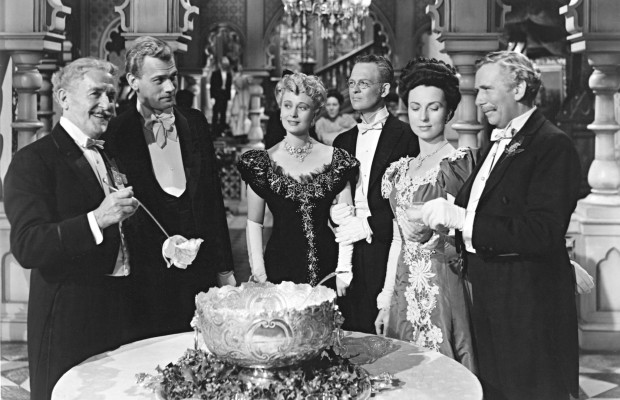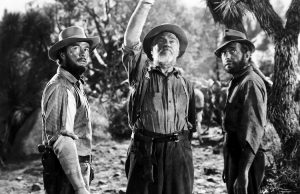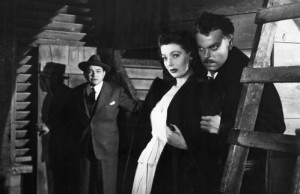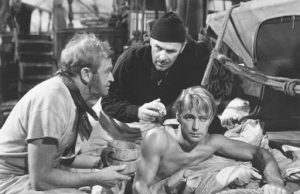The Magnificent Ambersons (1942)

Toronto Film Society presented The Magnificent Ambersons (1942) on Monday, May 7, 1979 in a double bill with Sudden Fear as part of the Season 31 Monday Evening Film Buff Series, Programme 10.
Production Company: Mercury Productions. Producer: Orson Welles. Executive Producer: George J. Schaefer. Director: Orson Welles, additional scenes directed by Freddie Fleck and Robert Wise. Distribution: RKO Radio. Assistant Director: Freddie Fleck. Associate Producer: Richard Wilson. Screenplay: Orson Welles, based on a novel by Booth Tarkington. Photography: Stanley Cortez, additional photography by Russell Metty, Harry Wild and Richard Makenzie. Art Direction: Mark Lee Kirk. Set Decoration: Al Fields. Special Effects: Vernon nL. Walker. Music: Bernard Herrmann, additional music by Roy Webb. Costumes: Edward Stevenson. Sound: Bailey Fesler and James G. Stewart. Editors: Robert Wise, Jack Moss and Mark Robson. Filmed between Oct. 28, 1941 and Jan. 22, 1942. U.S. release – August, 1942.
Cast: Orson Welles (Narrator), Tim Holt) George Amberson Minafer), Joseph Cotten (Eugene Morgan), Dolores Costello (Isabel Amberson Minafer), Agnes Moorehead (Fanny Minafer), Anne Baxter (Lucy Morgan), Ray Collins (Jack Amberson), Richard Bennett (Major Amberson), Don Dillaway (Wilbur Minafer), Erskine Sandford (Roger Bronson), J. Louis Johnson (Sam), Gus Schilling (Drugstore clerk), Charles Phillips (Uncle John), Dorothy Vaughan and Elmer Jerome (Spectators at the funeral), Olive Ball (Mary), Nian Guilbert and John Elliot (Guests), Anne O’Neil (Mrs. Foster), Kathryn Sheldon and Georgia Backus (Matrons), Henry Roquemore (Hardware man), Hilda Plowright (Nurse), Mel Ford (Fred Kinney), Bob Pittard (Charlie Johnson), Lillian Nicholson (Landlady), Billy Elmer (House servant), Maynard Holmes and Lew Kelley (Citizens), Bobby Cooper (George as a boy), Drew Roddy (Elija), Jack Baxley (Rev. Smith), Heenan Elliott (Labourer), Nancy Gates (Girl), John Maguire (Young Man), Ed Howard (Chauffer/Citizen), William Blees (Youth at accident), James Westerfield (Cop), Philip Moris (Cop), Jack Santoro (Barber), Louis Hayward (Ballroom extra).* Originally filmed at 131 minutes, but cut to 88 minutes before initial release.
Genius is an elusive quality, often subject to dispute in any art form but particularly contentious in film. George Orson Welles was incontestably a remarkably precocious child who very early displayed linguistic skills which marked him as a rare candidate for genius; e.g., by age 2 he spoke with an adult’s fluency and by age 3 he was reading Shakespeare. The attributes of his parents and their place in society further attenuated Welles’ childhood. “His parents separated when he was 6, and he spent two years with his mother in the company of musicians such as Ravel and Stravinsky, until her early death. …Living with his father he entered the world of the playboy and the showman. He himself learned to be a magician; among his teachers was Harry Houdini” (Weekend Magazine, p. 4). Welles’ remarkably precocious childhood created the spirit and the intellect which gave his adult works their recurrent markings of genius. He seems also to have acquired a nostalgic fascination with the lost world of childhood which recurrently supplied the sub-text of his major works. This sub-text distinctively permeates his first film, Citizen Kane (1941) which, despite its bizarrely marked reception, has persisted and become that rarest of phenomena, an American movie typically nominated as one of the ten greatest films ever made.
In much later years, Welles repeatedly remarked that Citizen Kane was the only film which he had ever made that was released as he had wished it to be. The identification of genius in art in obviously complicated when an artist’s uncontaminated production is limited to one film. Of Welles’ other films, he was to identify Touch of Evil (1958) as the most nearly complete of his films after Citizen Kane and he was to remain displeased with the laceration of the ending of The Magnificent Ambersons; however, it does appear that The Magnificent Ambersons is the third most complete of Welles’ major works. Although a few whimsical cuts were to blemish a few major sequences in the first half of the film, approximately the first hour of The Magnificent Ambersons is largely intact as it was in Welles’ original work. Only the last half of the original work was severely blemished by the staccato editing and the short but sophmoric rewriting that characterized the last third of the released film.
More than any other Welles’ films The Magnificent Ambersons is permeated by his nostalgic fascination with time past. Although The Magnificent Ambersons is unequivocally a major film in its own right, the inclusion of many apparently autobiographical touches gives it a distinctive place among Welles’s films. “Booth Tarkington had been a friend of Welles’s father, and the novel’s portrait of a ‘midland town’ passing into the twentieth century was surely reminiscent of Welles’s experience as a boy in the quasi-Victorian atmosphere of Kenosha and Woodstock. The book was written at about the time of Welles’s birth, so that certain of its characterizations struck quite close to home. The inventor Morgan and the beautiful Isabel Amberson are not unlike Welles’s own parents, and Isabel’s son George strongly resembles the insufferable young George Orson himself. An overprotected youth, George Amberson Minafer is universally hated by the townspeople, who describe him as a ‘fool boy with the pride of Satan’ and a ‘highhanded Lucifer’. When Isabel dies, leaving this son to become reconciled with a father-figure he has treated as a rival, the possible affinities with Welles’s life become even more intimate. In fact, it is interesting that the Oedipal triangle in the novel should be represented in the film by three players who have relatively weak personalities, as if they were simultaneously hinting at autobiographical parallels and defending against them. Eugene Morgan as portrayed by Joseph Cotten is more of a dandy than the Morgan in the book, and therefore presumably bears a greater resemblance to Welles’s father; yet Cotten is an actor who seems to have been born middle-aged, and is less sexually threatening to George than he should be. Dolores Costello, an agelessly beautiful silent movie actress who had come out of retirement, makes Isabel into a gold-haired madonna, a woman so abstracted into a complacently sweet and self-sacrificing role that she becomes almost invisible (although in the original version, before RKO revised a scene between her and her son, she was a stronger character). Tim Holt, as George, has dark, baby-fat looks that make him a double for the director, but he lacks the appropriate neurotic energy that Welles himself would have brought the part.” (Naremore, p. 107). Some students of Welles have found the unravelling of these autobiographical elements richly fascinating. Most people view the film on its own terms with no genuine awareness of Welles’ autobiographical borrowings.
The studio laceration of The Magnificent Ambersons has had the consequence of making afilm very few people ever saw an object of fascinated concern to many who consider Welles a profoundly significant film maker. The staccato editing of the last half of the original film was carried out by Robert Wise who many years later was to recall that 30 to 35 minutes of the original film were cut over the course of four previews before they arrived at what he characterized as a film that “the people sat for and we didn’t get a bad laugh” (Elwy Yost, TV interview with Robert Wise). Though that editing will continue to be a subject of dispute, it is true that the theme of the film had limited appeal to audiences at that time of its original release. nevertheless, over the decades since that time it has come to be recognized as at least a minor classic.
More than any other of Welles’ films, The Magnificent Ambersons shows the influence of his work in radio. The intermixing of multiple soundtracks which had been used in Citizen Kane and which was to characterize all of his major films was obvously a preoccupation of Welles’ in The Magnificent Ambersons. Moreover, it is largely structured as he had previously structured radio plays for the Mercury Theatre, one of which had been The Magnificent Ambersons. The film begins with a black screen and a gentle narration read by Welles himself. Though the use of the narrative device had characterized many radio plays, it was, at that time, relatively novel in the world of film. Since the making of The Magnificent Ambersons, the use of a voice over narration has become sufficiently commonplace in film that many people seeing the film for the first time might think of its use as more derivative than inventive. Up to the famous ball sequence, The Magnificent Ambersons more than anything else appears to be a brilliant cinematic realization of a radio play.
In large part because of Welles’ characteristic use of extended sequences, themselves typically formed from only a few carefully staged and photographed long takes, The Magnificent Ambersons is best analyzed in terms of the major sequences through which Welles tells his story. Most of the major sequences have an individual vividness which tends to embed them in the viewer’s mind, but never in a way that detracts f rom the almost lived sense of continuity that Welles characteristically strove to achieve.
The extended first part of the ball sequence was originally carefully staged and photographed by Welles as one long uninterrupted take. In the release print, this brilliant and cinematic take is marred by a number of small but slightly intrusive cuts that slightly detract from the fluid continuity of the original. The second major sequence of the film is the sleigh ride which presently runs for slightly less than 5 minutes. This sequence has an unusual authenticity both because of Welles’ use of long takes and the fact that it was staged and shot in an ice house rather than on the usual studio sound stage. The viewer can easily notice the gentle misting of the actors’ breath; a subtle detail that heightens the impression of reality in this winter sequence in a way never achieved on a sound stage. The next major sequence is the famous kitchen scene which is a single take of over 3 minutes improvised by George, Fanny and Uncle Jack after days of preparatory discussions.
After a factory sequence lasting little more than one and one-half minutes, Welles rapidly advances the plot through a montage sequence based on long takes involving Eugene and Isabel, and George and Lucy which is followed by an extremely brief montage of Uncle Jack and Major Amberson leading into the famous dinner and stairwell sequence that lasts slightly under eight minutes. Welles again reverts to a more rapid montage in which George’s attention is directed to a rumour concerning Eugene and Isabel. This is elaborated in the next few minutes to underscore George’s almost incestuous attachment to Isabel. This motif ends with a sequence between George and Isabel which in the release print lasts about 2 minutes, and in counterpart to this a final sequence between George and Lucy which lasts about three and one-half minutes.
With the implied departure of Isabel and George, the relatively unadulterated Wellesian part of the film ends. What remains of the film hurtles towards a non-Wellesian optimistic ending characterized by an irksome abbreviation of scenes in which only a few of Welles’ long takes are retained. Nevertheless, these few include the three minute sequence between Lucy and Eugene about an Indian myth that both know parallels their encounters with the Ambersons and a sequence of over 3 and one-half minutes between George and Fanny that is one of the famous sequences in which Agnes Moorehead transcends the limitations of her brief role. Approximately the last five minutes of the film become so chaotically brisk that most sense of character and action is obscured. Nevertheless, the overall impact of the film today seems undeniable and first hour shows Welles as an impressive master of subtlety and film technique rarely rivalled.
Trivia Notes: 1. Allan Dwan shot an entire B-movie in 10 days on sets left over from The Magnificent Ambersons.
2. In It’s a Wonderful Life, Frank Capra had James Stewart and Donna Reed set up housekeeping in a deserted old mansion that was originally constructed for and left standing after The Magnificent Ambersons.
References: The Magic World of Orson Welles, by James Naremore, 1978; Pieces of Time by Peter Bogdanovich, 1973; TV Interview with Robert Wise by Elwy Yost, 1978; Weekend Magazine, October 28, 1978.
Notes written by Marcia Gillespie and Lloyd Gordon Ward


















Leave a Reply